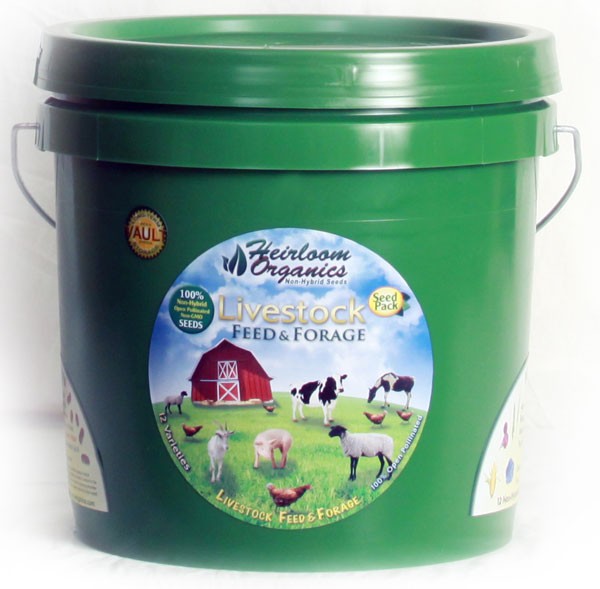

 |
 |
|
#1
|
|||
|
|||
|
I do like seeing new material coming out for MP. Though in Issue #2 of The Project that just got released, I saw one thing that just seemed off and did the math as I am wont to do.
The article mentions a cache type for a community that is one Pelican case with 1250 packets of seeds. The seeds are chosen for the region, climate, etc and are enough to supply four 100 acre farms for four years. Looking at some agricultural data, the average amount of seed for an acre of land using direct seeding (planting directly in the soil versus starter bed and transplanting seedlings) is right around two pounds. The average density of seeds is about 30 pounds per cubic foot. That comes out to 200 pounds per farm per year or 3200 pounds of seeds, or about 107 cubic feet. The largest Pelican case I can find is the Mobile Military MM08 Pallet-Ready case at 35.8 cubic feet (internal capacity). So three of these will do the job. It will still fit inside a large sewer vault as the article mentions, but to call it 1250 packets in a single case and imagining carrying the case, opening it and handing a farmer a few small packets to plant is not exactly the right image. |
|
#2
|
|||
|
|||
|
RPG designers and writers almost never do all the research and almost uniformly hate to do the math.
|
|
#3
|
||||
|
||||
|
Try searching Seed Bank Kits like Heirloom Seed Bank Kit, they should give you an idea of how the kits should look
__________________
I will not hide. I will not be deterred nor will I be intimidated from my performing my duty, I am a Canadian Soldier. Last edited by rcaf_777; 10-28-2017 at 08:25 PM. |
|
#4
|
||||
|
||||
|
|
|
#5
|
||||
|
||||
|
The image that ArmySGT. posted is very telling. That bucket supplies enough seed for a 2 acre plot. Just two acres. According to what else is on the website, that bucket holds 1.8lbs of seed but there are just over 55,000 seeds in that.
So using that as a basis for some really rough estimates, 100 acres would require 2,750,000 seeds so four x 100 acre farms would require 11,000,000 seeds. Even without that crude info, I think most people would realize that the proposed Pelican case of 1250 seeds is would be hopelessly unable to supply one 100 acre farm for even one year let alone four. So four farms for four years? The Project proposal isn't just overly optimistic, it's so ludicrous as to make you laugh. Or cry. The website that ArmySGT. linked to makes for a much better Project proposal. One bucket of 55,000 seeds for two acres appears to be enough to feed one family with some surplus so to my mind, a Project seed cache would be say, twenty of these 2lb pails (holding 1.8lbs of seed) to give 40 acres of crop. All that for just 40lbs weight and it's not particularly bulky. If all that crop is kept as seed then (again using rough & optimistic estimates), the next season you could potentially have 80 acres of crop. Yes it's going to take some time and probably requires the people being helped to be councilled not to eat the crop but if the Players like the rebuilding aspect then that sort of time period is a good tie to the community they're trying to help. |
|
#6
|
||||
|
||||
|
Farm Pail
 https://www.non-hybrid-seeds.com/sp/farm-pack.html List https://www.non-hybrid-seeds.com/fmp-var.html Homestead Pail  https://www.non-hybrid-seeds.com/sp/homestead-pack.html List https://www.non-hybrid-seeds.com/hp-var.html Livestock Pail  https://www.non-hybrid-seeds.com/sp/livestock-pack.html Last edited by ArmySGT.; 10-29-2017 at 08:47 AM. |
|
#7
|
|||
|
|||
|
So a few of those blue drums that can be used as rain barrel full of repackaged seeds should work.
|
|
#8
|
|||
|
|||
|
The 55-gallon blue rain barrel might be the best form factor for the original intent of the cache. You need just shy of 15 of them to hold the required number of seeds. Spread that over 16 barrels, and you have one barrel per 100 acre farm year. That way, each barrel will have enough empty space for educational material, like planting and growing guides, preservation techniques and a cookbook with balanced nutritional plans for the plants grown.
|
|
#9
|
||||
|
||||
|
I go with the Pelican 1630 M.O.B. Case for the seeds and education material, and have 55-gallon blue barrel packed with a crop irrigation kit.
https://www.earlysgarden.com/compone...t2-700x700.jpg
__________________
I will not hide. I will not be deterred nor will I be intimidated from my performing my duty, I am a Canadian Soldier. |
|
#10
|
|||
|
|||
|
I'm REALLY not comfortable with the idea that the Project could store sufficient seeds for several farms. Would it not be more plausible to have enough seeds for lots of vegetable gardens? That way, the Project could provide a way for people to obtain the necessary micro-nutrients and vitamins
This might be an interesting possibility http://www.carbon.org/catalog/pub/disasterkit.htm |
|
#11
|
|||
|
|||
|
Does it really matter? Barring some exceptional technique, the team should know when they wake up and discover the year that these seeds are no longer viable. I wouldn't waste too much time on an irrelevant set of crates that should be immediately abandoned.
|
|
#12
|
|||
|
|||
|
Of course it matters. Seeds found in many places that have produced viable plants have been carbon dated as being more that 1000 years old a number of times. It all depends on storage conditions. At 150 years of well controlled storage you will have a lower rate of germination, maybe lower than 40%, but that can still be useful.
Last edited by mmartin798; 10-31-2017 at 09:55 AM. |
|
#13
|
|||
|
|||
|
Quote:
|
|
#14
|
|||
|
|||
|
And some references on permaculture, other sustainable farm techniques. Spare tool handles, for 5 years after there would be a lot of heads in garages and barns.
|
|
#15
|
||||
|
||||
|
Wandering around the net looking for sites that relate to this topic, I found the following information from this site: - https://www.thespruce.com/how-many-v...garden-1403355
Quote: In “How To Grow More Vegetables”, intensive gardening guru, John Jeavons, says you’ll need about 200 sq.ft. per person to grow enough vegetables and soft fruits for the growing season at intermediate yields. To grow all the food for one person's needs for the whole year requires, for most people, at least 4,000 square feet—though some diet designs are possible that can use a smaller area. :EndQuote 200 sq.ft per person or for those of us in metric, approximately 18.6 sq. metres. For comparison purposes, 1 acre = 43,560 sq.ft. So in regards to Morrow teams trying to help out with agriculture, a typical vegetable garden as we envisage it, would be a supplement to whatever other food gathering practices a settlement has. The idea of stocking seeds to help establish even 2 acres of crop will obviously need a substantial amount of seed (based on the figures for a 2 acre plot in the website that ArmySGT. linked to). Rereading the cache description provided by mmartin798 I realize that I thought the cache held only 1250 seeds but it actually meant 1250 packets of seeds. Even with that correction I think that those packets will not hold enough seed for a single 100 acre farm for four years let alone four 100 acre farms for four years. I think it would work better if that allocation of 1250 packets was meant to supply up to 100 acres of crop, but 400 acres and for four years just seems wildly optimistic. NB: For all the conversions I've been using http://www.onlineconversion.com/area.htm |
|
#17
|
||||
|
||||
|
Quote:
Heirlooms are old varieties that have become uncommon due to mega farms and mono cropping. Saving seed from each harvest will produce true and full varieties of the seed saved. Depending on the fruit or vegetable 10% to 50% would need to be unharvested until fully ripened to produce seed (onions. turnips, corn, etc). Tomatoes, squash, melons, are notorious for their seeds and none would have to be held back or ripened past a point for quality consumption to have enough seed for the nest years harvest. |
|
#18
|
|||
|
|||
|
Quote:
|
|
#19
|
|||
|
|||
|
Quote:
1) Every species has its own period of viability. Some seeds are viable for centuries, some for decades, some for a few years. 150 years after sealing, most of the varieties will be long past their sell-by date, even if a few are still within range. 2) Not all seeds within a given species expire at the same time. If the mean survival of seed X under conditions Y is 15 years, then a few will likely still be viable at 30 or 50 years, but most will be long dead. 3) A lot of the news stories about ancient seeds being recovered miss that growing them required exceptional techniques and/or a lot of seeds per growing plant. The "Methuselah Tree" that was grown from a 2,000 year old seed was the work of a single dedicated grad student subjecting the seed to a number of techniques and materials that were not part of standard agricultural practice. The squash mentioned above does not indicate how many seeds it took or what the grower did to cultivate them, but I would be willing to bet that it wasn't "plant one seed, water and fertilize, yield one plant". So my point is that if the viable period of the seeds is 10 years, then 150 years later there may be a small fraction of one or two varietals that will still grow with what the typical Team can do, but if the Project is going to grow from their seeds then they will likely need a better seed vault where the Project uses special techniques and facilities and personnel to preserve a variety of breeds long past their viable dates. And there is one other point, I guess: Who is going to use this in a game? As has been noted by many on here, it is hard to get most players to get past shooting, I can't imagine a situation where an actual group of players is going to turn to an actual GM and ask about seed details so they can start the agricultural development stage of the Project. In every game I've ever played, these seeds are going to see two possibilities: being ignored, or being discarded. I don't see a player group doing any actual agriculture... ever. |
|
#20
|
|||
|
|||
|
Your points are valid. Even studies from 1961 showed that most food seeds do die off in large quantities within 70 years, though legumes were shown to be particularly hardy in this regard. This all seems to be a problem with the walls of the seeds being thinner on food crops. Weeds, with their thicker walls, can live several decades without careful storage and still be viable in large quantities.
Food seeds routinely get treated in a number of methods to inhibit molds and other pathogens that hamper seed germination. It is not outside the realm of possibility that, given the prevalence of nanotechnology in the Project, a graphene treatment is used that helps mitigate moisture loss and thereby improving seed viability. While this would not make the seeds immortal, such a treatment could help achieve the 40% viability at 150 years that would make such a cache still useful. The whole seed issue does need to be addressed in some manner, as they are present in so much of game canon. Third edition has agricultural teams and seeds explicitly listed in Delta Base. Fourth edition also has agricultural teams and says they have seed stores and frozen livestock as well. So all these agricultural teams are either just some additional farmers with a supply of fertilizer trying to improve on some wild plants they find or they have the ability to quickly start up some new farms with their supply of seeds and start churning out lots of food and surplus seeds within three years. Either way could be a scenario for your game. As to who would use the seeds in game, back in 1981 my group used them to help a community that had recently be attacked by raiders that burned their fields. So play group vary too. |
|
#21
|
|||
|
|||
|
Quote:
|
|
#22
|
|||
|
|||
|
Quote:
|
|
#23
|
|||
|
|||
|
Quote:
And without that strangely prescient and expensive focus on preserving seed stock for 30x longer than it was expected to be needed, the stored seeds are almost entirely dead, with only a small percentage of a few varieties still viable. So why worry about the SWAP constraints of dead seeds? Quote:
And did the variety or mass or volume of those seeds factor in any significant way to game play? How about the percentage of viable seeds? I've had teams that distributed seeds to communities as well (mostly at Starnaman) but never in circumstances where the details would be anything but a way to unnecessarily complicate part of the game that no one cared about. |
|
#24
|
|||
|
|||
|
It makes a lot of sense for me for there to be a few locations using more advanced preservation techniques on a relatively small quantity of seeds and animals - they can be used as emergency stocks, as biological experimental and reference samples, and as a hedge in case something goes wrong with the less-protected seed stocks issued to field teams. But that doesn't do anything to make the tubs/sacks/whatevers of seeds in the boltholes anything but mostly dead.
|
|
#25
|
|||
|
|||
|
Quote:
Put another way, a Team focused on regional security faces very different challenges and will need very different tools depending on whether they are dealing with a war+5 population or a war+150 population. If the Team in question had, for some reason, one or more systems that depended on gasoline, they would in the latter case need to deal with the fact that their gasoline stores are no longer viable and that using those systems would require looking outside Morrow stocks. This is one of the reasons I am against jet aircraft in Project inventories and why I think the seed stocks (although both more durable and necessary) represent a resource that the Teams will need to replace. |
|
#26
|
|||
|
|||
|
We are looking for writers for the magazine. Right now it's a one man show doing all the work. Additional help would be absolutely wonderful and possibly if we get enough help the Project could end up a quarterly release.
|
|
#27
|
||||
|
||||
|
Quote:
Writers guide? Submission guide? Some starting point please! |
|
#28
|
|||
|
|||
|
where can I find the Project Issue magazine?

|
|
#29
|
|||
|
|||
|
Here are links to both issues of The Project
The Project Issue #1 http://tomorrowsend.rpgstuff.net/wp-...ne-Issue-1.pdf Thr Project Issue #2 http://tomorrowsend.rpgstuff.net/wp-...ct-Issue-2.pdf |
|
#30
|
|||
|
|||
|
Quote:
Submission Guidelines The Project is dedicated to expanding and supporting the work of professional and aspiring writers with a straightforward presentation of The Morrow Project RPG game information, gaming instruction and fiction and adventure modules or even settings. Our editor is interested in articles on all gaming topics written by emerging and experienced writers in all genres. We are looking for clear takeaway for our readers: What can they learn to improve their gaming or running a game? What how-to tips and strategies will accomplish this? Also Game Fiction as well as even simple things like a fully flushed out NPC. Queries should briefly describe your background and provide details for your story idea. We are interested in how-to stories, how to pieces, narrative stories, playable small mini adventures, settings, towns, equipment, etc. We are not interested in pieces that have been previously published online or in print. We do accept queries that include finished pieces for consideration. We do not accept material that has been previously published in any form in print or online. Queries should be sent by e-mail to timgray1@gmail.com. Please include your name, and a short bio on your Morrow Project gaming experience. Article lengths vary widely from 300 to 3,000 words. On occasion, longer articles and excerpts also appear in the magazine. |
 |
| Currently Active Users Viewing This Thread: 1 (0 members and 1 guests) | |
| Thread Tools | Search this Thread |
| Display Modes | |
|
|